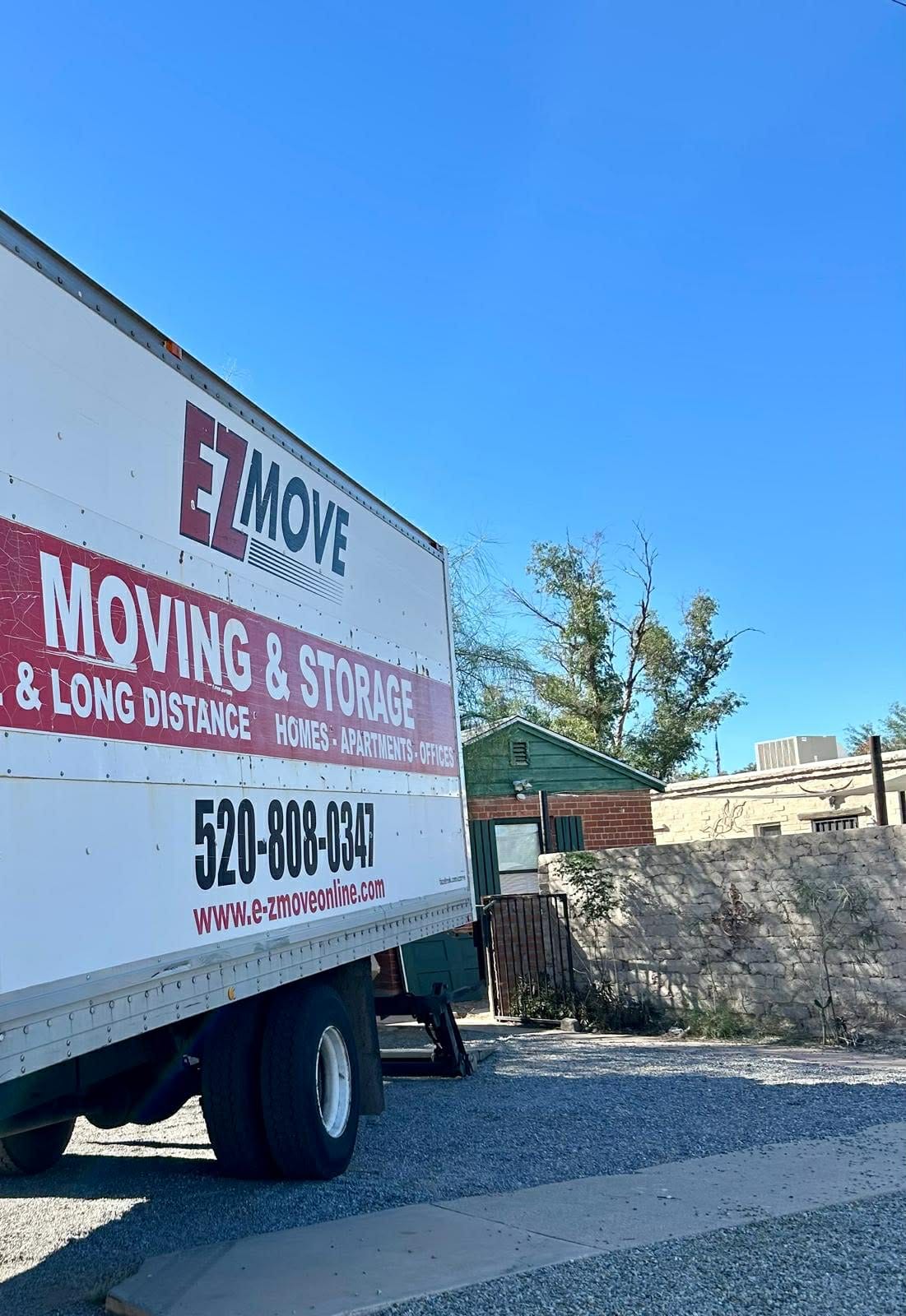You’ve circled dates on your calendar, packed half your kitchen into cardboard boxes, and hired a moving truck. Then you check the weather forecast and see those ominous words: monsoon warning. If you’re planning a relocation in southern Arizona between June and September, you need to understand how these powerful summer storms can turn your carefully organized moving day into a logistical challenge.
What Makes Tucson’s Monsoon Season Different
Tucson experiences one of North America’s most dramatic weather patterns each summer. The monsoon season officially runs from June 15 through September 30, though the most active period typically occurs in July and August. Unlike gentle spring showers, these storms bring sudden downpours, lightning strikes that illuminate the entire valley, wind gusts exceeding 50 miles per hour, and occasional flash flooding that can make roads impassable within minutes.
The National Weather Service tracks these storms carefully because they create genuine hazards. Roads that look perfectly dry at noon can become rushing rivers by 3 p.m. The desert soil doesn’t absorb water quickly, which means even moderate rainfall produces runoff that overwhelms drainage systems. For anyone coordinating a household move, these conditions create problems that go far beyond getting a few boxes wet.
How Weather Patterns Impact Moving Logistics
When you’re working with E-Z Move, understanding monsoon timing becomes part of your planning process. Most storms develop in the afternoon and early evening, typically between 2 p.m. and 8 p.m. This pattern happens because morning sunshine heats the ground, creating rising air currents that eventually form towering thunderheads by mid-afternoon.
Your morning moving schedule might proceed without issues, but by the time you’re loading furniture from your second-floor apartment, the sky has turned threatening shades of gray and green. Professional movers track weather radar constantly during monsoon season, but even with technology, these storms can develop faster than anyone anticipates. What appears as a small system twenty miles away can explode into a major storm directly overhead within thirty minutes.
Temperature drops of 20 to 30 degrees often accompany these storms. You might start your moving day sweating in 105-degree heat, then find yourself shivering in 75-degree air with wind whipping rain sideways. This rapid change affects more than your comfort. Humidity spikes from 10 percent to 60 percent or higher, which creates problems for electronics, wooden furniture, mattresses, and any items vulnerable to moisture damage.
Protecting Your Belongings During Summer Storms
Cardboard boxes lose their structural integrity when wet. A box that easily holds forty pounds of books becomes a soggy disaster waiting to collapse when moisture seeps through the bottom. During monsoon season, you need to think differently about how you pack and protect your belongings.
Heavy-duty plastic bins with sealed lids provide better protection than cardboard for items you’re loading during uncertain weather. These containers cost more upfront, but they’re reusable and they keep contents dry even if they sit in a puddle. For furniture and appliances, moving blankets and plastic wrap create essential barriers against moisture. That leather couch or wooden dining table represents significant investment, and water damage from a single storm can cause warping, staining, or mold growth that’s expensive to repair.
Electronics need special attention. Televisions, computers, gaming systems, and sound equipment should go inside protective cases or boxes with extra padding. Even if these items don’t get directly wet, humidity alone can cause internal condensation that damages circuitry. Professional movers typically wrap electronics in plastic before covering them with blankets, creating multiple layers of protection.
Timing Your Move Around Storm Patterns
The Arizona Meteorological Network provides detailed forecasts that help you make informed decisions about moving schedules. Checking weather predictions three to five days ahead gives you a general idea of storm probability, though monsoons remain notoriously difficult to predict with precision. You can’t control the weather, but you can control how you respond to forecasts.
Early morning moves during monsoon season offer the best chance of avoiding storms. If you can start loading at 6 a.m. or 7 a.m., you typically have until early afternoon before storm development becomes likely. This strategy requires coordination with your moving crew and possibly your landlord or property manager, but it significantly reduces weather-related complications.
Split moves provide another option. Rather than trying to complete everything in one day, you can move stable items during questionable weather and save vulnerable belongings for days with better forecasts. This approach works better for local moves where you can make multiple trips between properties. Long-distance relocations require different strategies since you can’t easily split the timeline across multiple days.
Road Conditions and Flash Flooding Concerns
Tucson’s streets weren’t designed for the amount of water that falls during monsoon storms. The city sits in a valley surrounded by mountains, and when rain hits those slopes, water rushes downward through natural channels and man-made drainage systems. Low-lying areas and dips in roads collect water quickly, creating hazards for vehicles, especially large moving trucks.
The Pima County Regional Flood Control District maintains maps showing areas prone to flooding, and these maps should influence your route planning. Major underpasses along I-10 and surface streets near washes can become completely submerged during heavy storms. A moving truck that gets stuck in flood water faces expensive recovery costs, potential damage to the vehicle, and risk to everyone involved.
Arizona law prohibits driving around barricades placed at flooded crossings, and the “Stupid Motorist Law” allows authorities to charge drivers for rescue costs if they ignore warnings and become stranded. When you’re piloting a 26-foot moving truck loaded with everything you own, taking chances with flood water isn’t worth any amount of schedule pressure. Sometimes the smartest decision means pulling over and waiting thirty minutes for water to recede.
Insurance Considerations for Weather-Related Damage
Standard moving insurance policies cover various types of damage, but understanding what’s included for weather-related losses matters when you’re moving during monsoon season. Basic carrier liability, which most moving companies provide at no extra cost, typically covers only 60 cents per pound per item. That means your 50-pound television receives a maximum of $30 if it’s damaged, regardless of replacement cost.
Full value protection offers more comprehensive coverage but comes with higher premiums. This coverage obligates the moving company to repair damaged items, replace them with similar articles, or provide cash settlement for current market value. However, even full value protection may include exclusions for certain weather-related scenarios, particularly if you chose to proceed with a move despite severe weather warnings.
Homeowners or renters insurance sometimes extends coverage to belongings during a move, though this varies by policy. Contact your insurance agent before moving day to clarify what’s covered and whether purchasing additional protection makes sense. Documentation proves essential if you need to file a claim. Photograph valuable items before packing them, keep receipts for electronics and appliances, and maintain a detailed inventory of box contents.
Lightning Safety During the Moving Process
Arizona ranks among the top states for lightning strikes, and monsoon season concentrates this activity into a few intense months. The National Weather Service recommends the 30-30 rule: when you see lightning, count the seconds until you hear thunder. If that count reaches thirty seconds or less, the storm is within six miles and poses a genuine threat. Seek shelter immediately and wait thirty minutes after the last thunder before resuming outdoor activities.
Moving requires you to work outside, but you can take breaks that minimize risk. When storms approach, professional movers typically stop loading and wait inside until lightning danger passes. Standing in a truck bed, carrying metal furniture, or working near trees all increase your risk during electrical storms. Getting behind schedule feels frustrating, but lightning kills an average of twenty people annually in the United States, and rushing through dangerous conditions isn’t worth that risk.
If you’re caught outside when lightning becomes imminent, crouch low with feet together, minimizing contact with the ground. Don’t lie flat. Avoid isolated trees, metal structures, and open fields. A hard-topped vehicle with windows rolled up provides reasonable protection, making the cab of your moving truck a safer option than standing in an empty parking lot.
Preparing Your New Home for Monsoon Season
Before you start unpacking boxes at your new property, take time to assess the home’s readiness for monsoon conditions. Check that gutters and downspouts are clear of debris so they can handle heavy water flow. Verify that doors and windows seal properly to prevent water intrusion. Look at the grading around the foundation to confirm that ground slopes away from the structure, directing water outward rather than toward your basement or crawl space.
If you’re moving into a home with a yard, identify where water naturally flows during storms. Low spots that collect water should stay clear of boxes and furniture during your move-in process. Desert landscaping typically includes drainage channels or dry creek beds designed to handle runoff, and you’ll want to keep these areas accessible rather than blocking them with moving trucks or temporary storage.
Power outages occur frequently during monsoons, sometimes lasting hours if storms damage electrical infrastructure. Before unpacking your entire kitchen, locate the circuit breaker panel and confirm you have flashlights and batteries accessible. Set up essential rooms first so that if power goes out, you have functional sleeping and bathroom areas ready.
Why Professional Experience Matters During Monsoon Season
When you book Tucson movers with local experience, you’re getting more than muscle and trucks. Companies familiar with Arizona’s monsoon patterns understand how to read radar, when to pause work, and how to protect belongings against sudden weather changes. They carry equipment specifically designed for weather protection, including heavy-duty tarps, plastic sheeting, and tie-downs that secure loads against wind.
Local moving professionals know which routes flood first and which alternatives provide safer passage. They’ve experienced enough monsoon seasons to make quick decisions about whether to wait out a storm or proceed with caution. This knowledge prevents the costly mistakes that can happen when inexperienced movers push forward despite dangerous conditions.
Professional crews also maintain proper insurance and safety protocols that protect you from liability. If someone gets injured during a lightning storm or a truck hydroplanes on a flooded street, comprehensive insurance coverage becomes the difference between a manageable situation and a financial catastrophe. Cutting costs by hiring the cheapest option often backfires when that budget operation lacks proper protection for weather-related incidents.
Creating a Backup Plan for Your Moving Day
Even with perfect planning, monsoons sometimes force schedule changes. Creating a backup plan before moving day eliminates the stress of making rushed decisions when storms disrupt your timeline. Confirm with your moving company how they handle weather delays. Most professional operations include flexibility in their contracts, but understanding the specific terms prevents confusion when you need to exercise those options.
If you’re moving out of a rental property, communicate with your landlord about potential weather delays. Most property managers understand that monsoon season creates legitimate scheduling challenges, and they’d rather accommodate a one-day delay than have you damage property by rushing through dangerous conditions. Get any date flexibility in writing so you’re protected if storms force postponement.
Temporary storage provides another backup option. If you must vacate your current home by a specific date but storms prevent immediate move-in at your new location, short-term storage facilities offer climate-controlled spaces that protect belongings until conditions improve. This costs more than a direct move, but it’s cheaper than replacing damaged furniture or dealing with the complications of a partially completed move.
Essential Supplies for a Monsoon Season Move
Beyond standard moving supplies, monsoon season requires additional items that protect against weather challenges. Heavy-duty tarps in various sizes let you cover furniture, create sheltered work areas, and protect the interior of moving trucks. Choose tarps with reinforced grommets and bring extra bungee cords or rope to secure them against wind.
Towels and microfiber cloths help wipe down items that get splashed despite your best efforts. Keep these accessible rather than packing them in boxes you won’t open until later. Change of clothes for everyone involved in the move prevents the misery of working in wet garments for hours. Extra shoes matter too since wet footwear becomes uncomfortable quickly and can make walking up ramps or stairs hazardous.
First aid supplies deserve a spot in your moving day essentials. The combination of rushing, fatigue, slippery surfaces, and distraction creates injury risks. Band-aids, antibiotic ointment, pain relievers, and ice packs address common problems without requiring emergency room visits. Keep a cooler with cold drinks and snacks accessible too, since hydration remains critical even when temperatures drop during storms.
Making Peace with Monsoon Season Moving
Thousands of people successfully move during Tucson’s monsoon season every year. The storms create challenges, but they don’t make relocation impossible. Success comes from respecting the weather, planning with flexibility, and working with professionals who understand local conditions. Your move might take longer than anticipated, require schedule adjustments, or demand extra protective measures, but with proper preparation, you’ll get your belongings safely to your new home.
The monsoon season brings beauty along with challenges. Those dramatic storms that complicate your moving day also green the desert, fill reservoirs, and create spectacular sunsets once the clouds begin to break. Years from now, you might remember your move as the day you watched lightning dance across the Catalina Mountains while huddled in a moving truck, waiting for the storm to pass. Sometimes the unexpected moments become the memorable ones, even when they’re not part of your original plan.



